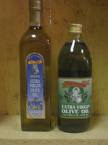Why not EVOO from Spain

Here's an image of the evoo brand I would like to have the next time I buy my supply of olive oil.
Alcubilla is an olive oil mill which exclusively produces Extra Virgin Olive Oil extracted from certified organically farmed olives. Alcubilla is owned by the Luque family from Castro del Rio, Cordoba in Spain. They have been in the olive oil business since 90 years ago.
This evoo “is an artisan-made fruit juice” which does not undergo any heating process. In 1990, Alcubilla obtained the Certificate of the Committee for the Regulation of Organic Agriculture which means that what they say about their olive oil is true and accurate.
Futhermore, Alcubilla has developed a tracking system which controls the production process of its evoo brand from the harvest of the olives till it reaches the dinner table.
I have been using Filippo Berio and Bertolli from Italy since I have been introduced to olive oil but got worried when I read this.
Olive Oil and More from Wikipedia:
The International Olive Oil Council (IOOC) is an intergovernmental organization based in Madrid, Spain, with 23 member states. It promotes olive oil around the world by tracking production, defining quality standards, and monitoring authenticity. More than 85% of the world's olives are grown in IOOC member nations.
The United States is not a member of the IOOC, and the US Department of Agriculture does not legally recognize its classifications (such as extra-virgin olive oil). The USDA uses a different system, which it defined in 1948 before the IOOC existed. The California Olive Oil Council, a private trade group, is petitioning the USDA to adopt IOOC rules.
The IOOC officially governs 95% of international production and holds great influence over the rest. IOOC terminology is precise, but it can lead to confusion between the words that describe production and the words used on retail labels. Olive oil is classified by how it was produced, by its chemistry, and by its flavor.
All production begins by transforming the olive fruit into olive paste. This paste is then malaxed to allow the microscopic oil droplets to concentrate. The oil is extracted by means of pressure (traditional method) or centrifugation (modern method). After extraction the remnant solid substance, called pomace, still contains a small quantity of oil.
Retail grades in IOOC member nations
As IOOC standards are complex, the labels in stores (except in the U.S.) clearly show an oil's grade:
1. Extra-virgin olive oil comes from cold pressing of the olives, contains no more than 0.8% acidity, and is judged to have a superior taste. There can be no refined oil in extra-virgin olive oil.
2. Virgin olive oil has an acidity less than 2%, and judged to have a good taste. There can be no refined oil in virgin olive oil.
3. Pure olive oil. Oils labeled as Pure olive oil or Olive oil are usually a blend of refined olive oil and one of the above two categories of virgin olive oil.
4. Olive oil is a blend of virgin oil and refined oil, containing no more than 1.5% acidity. It commonly lacks a strong flavor.
5. Olive-pomace oil is a blend of refined pomace olive oil and possibly some virgin oil. It is fit for consumption, but it may not be called olive oil. Olive-pomace oil is rarely found in a grocery store; it is often used for certain kinds of cooking in restaurants.
6. Lampante oil is olive oil not used for consumption; lampante comes from olive oil's ancient use as fuel in oil-burning lamps. Lampante oil is mostly used in the industrial market.
Label wording
Olive oil vendors choose the wording on their labels very carefully.
1. "100% Pure Olive Oil" is often the lowest quality available in a retail store: better grades would have "virgin" on the label.
2. "Made from refined olive oils" suggests that the essence was captured, but in fact means that the taste and acidity were chemically produced.
3. "Light olive oil" actually means refined olive oil, not a lower fat content. All olive oil has 120 calories tablespoon (34 /ml).
4. "From hand-picked olives" may indicate that the oil is of better quality, since producers harvesting olives by mechanical methods are inclined to leave olives to over-ripen in order to increase yield.
5. "First cold press" means that the oil in bottles with this label is the first oil that came from the first press of the olives. The word cold is important because if heat is used, the olive oil's chemistry is changed. It should be noted that extra-virgin olive oil is cold pressed, but not necessarily the first oils.
6. "Bottled in Italy" or "Packed in Italy" does not necessarily mean that the olive oil originated in Italy. Back or side labels indicate the origin of the olive oil which is often a mixture of oils from several nations.